There’s just something completely charming about ladybugs.
Even people who get uptight at the mention of the “b” word are often more than okay with these beautiful and benevolent little beetles.
That glossy red shell, those dainty polka dots …
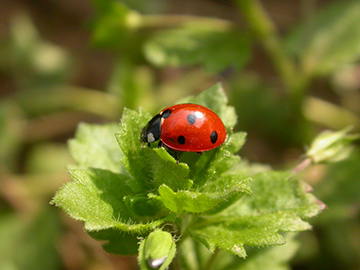
Photo by Gilles San Martin from Namur, Belgium via Wikimedia Commons
Darling!
Of course, it doesn’t hurt that ladybugs are marvelous allies in the garden.
But, first things first …
How Did the Ladybug Get “Her” Name?
Legend has it that during the Middle Ages in Europe, a swarm of aphids fell upon fields of crops, leaving desperate farmers with little choice but to implore the Virgin Mary for help. And what do you know? Legions of tiny crimson beetles soon landed, as if descending straight from the heavens. They began devouring the aphids and saved the crops. In gratitude, the farmers named their fortuitous visitors “Our Lady’s Beetles.”
Divine Diversity
Over 450 species are native here in North America (who knew?), and they can sport a surprising array of outfits: orange, yellow, pink, gray—even brown or black.
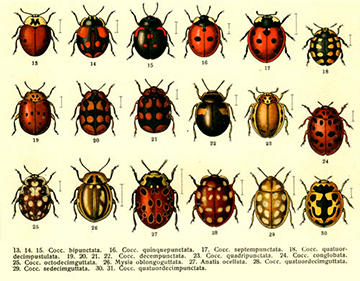
Photo courtesy of Ladybug-life-cycle.com
Gardeners and Ladybugs: A Love Affair
Aphids are the bane of many a gardener, and as luck would have it, ladybugs are excellent aphid eaters, both in their larval and adult forms.
FYI, these are ladybugs at three different life stages:
One little “lady” can consume up to 50 to 60 aphids per day, and it will also eat a variety of other insects and larvae such as scales, mealy bugs, leaf hoppers, mites, and soft-bodied insects. The eggs of the dreaded Colorado potato beetle and European corn borer are also on the menu.
“They are tremendous carnivores that can eat lots of significant agricultural pests,” says Doug Taron, curator of biology at the Peggy Notebaert Nature Museum in Chicago where ladybugs are used to naturally control pests in the museum’s butterfly garden.
Ladybugs lay hundreds of eggs in the colonies of aphids and other plant-eating pests. When they hatch, the ladybug larvae immediately begin to feed.
Get ‘Em In Your Garden
In recent years, it has become a popular notion to buy ladybugs from gardening catalogs and release them into home gardens. While this sounds like a great idea, it doesn’t really fly for three reasons:
- Once released, most mail-order ladybugs will migrate out of your garden before settling down to eat and multiply.
- Ladybugs ordered by mail are likely an exotic species such as the Asian Lady that will aggressively displace our native varieties. Asian Ladies were introduced in the United States to control aphids on crops, but they soon became pests, outcompeting native species and wintering by the hundreds inside homes. These little buggers are even known to bite!
- When commercially sold ladybugs are introduced in new areas, they can spread parasites and diseases that may not have been present in local populations.
So, instead of buying ladybugs, lure them naturally …
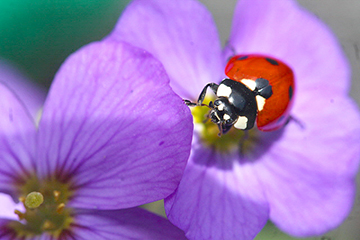
Photo by Maelfeyt via Wikimedia Commons
First rule of thumb: no pesticides. Chemical bug killers are not only harmful to ladybugs, but they also kill the ladies’ food sources, leaving them no reason to hang around your garden. Come to terms with the presence of aphids, and let ladybugs keep them in check for you.
Ladybugs supplement their insect diet with pollen and nectar, so if you plant some of their favorite flowers, they will find sweet reasons to stick around.
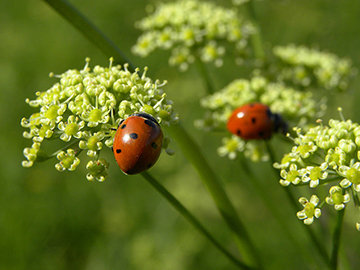
Photo by Haeferl via Wikimedia Commons
Try these:
- Cone Flower
- Sunflower
- Yarrow
- Angelica
- Tansy
- Wild Carrot
- Cilantro
- Dill
- Cosmos (especially the white variety)
- Coreopsis
- Scented Geraniums
- Dandelions
Join the Lost Ladybug Project
Over the past 20 years, several native ladybug varieties have become extremely rare due to competition from imported ladybugs. “This is happening very quickly and we don’t know how, or why, or what impact it will have on ladybug diversity or the role that ladybugs play in keeping plant-feeding insect populations low,” explains Cornell University entomologist John Losey.
Losey is the driving force behind the Lost Ladybug Project, which encourages people to act as “citizen scientists” by reporting ladybug sightings across the country. He hopes that the data will provide insight into protecting native ladies and the vital role they play in both wild and cultivated ecosystems.
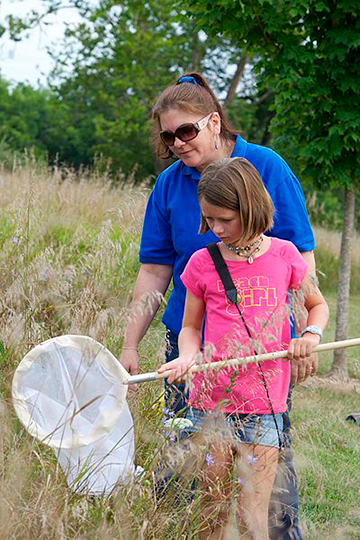
Photo by Ryan Hagerty, U.S. Fish and Wildlife Service, via Wikimedia Commons
- Find out how you can become a citizen scientist for the Lost Ladybug Project here.
- Learn to identify common kinds of ladybugs here.













































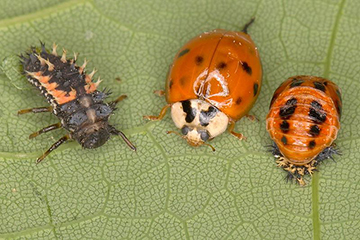








This story is right on spot;-) today as I just came indoors after playing in the garden for awhile. And guess what I noticed & took pictures of while I was outside this morning…indeed, it was a Ladybug. Our Lady was resting quietly on the Boneset plant.
Thank you for sharing the, “How the Ladybug got her name” story; that is a beautiful legend which I had not heard of until now. I’m also happy to read the above list of plants for attracting ladybugs & can honestly say we have them all growing in our yard:-)…& then some. I hope the ladybug I spotted;-) this morning works her way over to the honeysuckle because some little buggers are draining the honeysuckle buds dry; so far only one bud has opened to produce a flower.
Thanks for all the links MaryJane, I will most likely sign-up for the ‘Lost Ladybug Project’ (I love those kinds of things) & will visit the learn to identify lady-link again & again. Looks like we usually have the Harmonia(?) type fly into our yard? I need to see what the imported ladies look like so I don’t nurture those as well:-)
How approppriate an article this was! I just came inside, and when I took off my long-sleeved gardening shirt, there was a lovely little lady on it, so I just went out the front door and deposited her on the rose bush which needs her. Hope she likes it!
I saw my first Lady Bug this week! A sign that spring has finally arrived for us at 9000 feet in the Mountains off Colorado!
Hi Maryjane,
I made the mistake of not jotting down the address of the artist who creates pictures using vegetable stickers. I’ve filled up a plastic sheet with these and I’m ready to mail them to the man. Please let me have his address so I may send them on. Keep up this most useful and wonderful website of yours that touches on so many aspects of our lives.
Yours, Ellen Ottoson
What a lovely article Maryjane! So nice to know that not all people look at insects as harmful creatures.